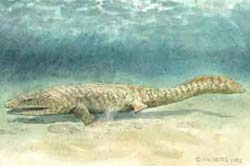
In the 19th century a fossil was uncovered in Belgium that was believed to be the jaw of a fish. Now a team of scientists have shown that it is in fact a fossil from an ancestor of all present-day land animals. It is the first discovery of a so-called tetrapod from the Devonian Period in continental Europe, which may trigger an interest in re-examining objects in museums.
In collaboration with researchers from France, England, and Belgium, Per Ahlberg, professor of evolutionary organism bio
Approximately 75,000 years ago, a massive explosive eruption from a volcano in western Indonesia (Toba caldera) coincided with the onset of the Earth’s last Ice Age.
In the current issue of Geology, University of Rhode Island geological oceanographers Meng-Yang Lee and Steven Carey; Chang-Hwa Chen and Yoshiyuki Iizuka of the Academia Sinica in Taiwan; and Kuo-Yen Wei of National Taiwan University describe their investigation into the possibility that eruptions from the Toba caldera on
A statistical model from Ohio State University is forecasting sea surface temperatures in the tropical Pacific Ocean in a new way.
The model gives scientists a way to quantify the uncertainty that surrounds the climatic phenomenon known as El Niño, which triggers severe weather changes in North and South America and Australia and endangers crops and wildlife, said Noel Cressie, professor of statistics and director of the university’s Program in Spatial Statistics and Environmental Sci
Scientists interested in the Earth’s carbon cycle – something that must be understood to assess the ongoing effects of carbon dioxide created by human actions, such as driving cars – have a new problem. They need to adjust various calculations because one component, graphitic black carbon, similar to the material found in pencil lead, turns out to be so tough.
In a letter in today’s issue of Nature, researchers say that graphitic black carbon is created as sedimentary rocks undergo
What if a personal computer knew how its user is feeling?
That computer on your desk is just your helper. But soon it may become a very close friend. Now it sends your e-mails, links you to the Web, does your computations, and pays your bills. Soon it could warn you when you’re talking too much at a meeting, if scientists at Sandia National Laboratories’ Advanced Concepts Group have their way. Or it could alert others in your group to be attentive when you have something imp
Early humans migrating from Africa carried small genetic differences like so much flotsam in an ocean current. Today’s studies give only a snapshot of where that genetic baggage came to rest without revealing the tides that brought it there. Now researchers at the Stanford University School of Medicine have devised a model for pinpointing where mutations first appeared, providing a new way to trace the migratory path of our earliest ancestors.
The study was led by Luca Cavalli-Sforza,